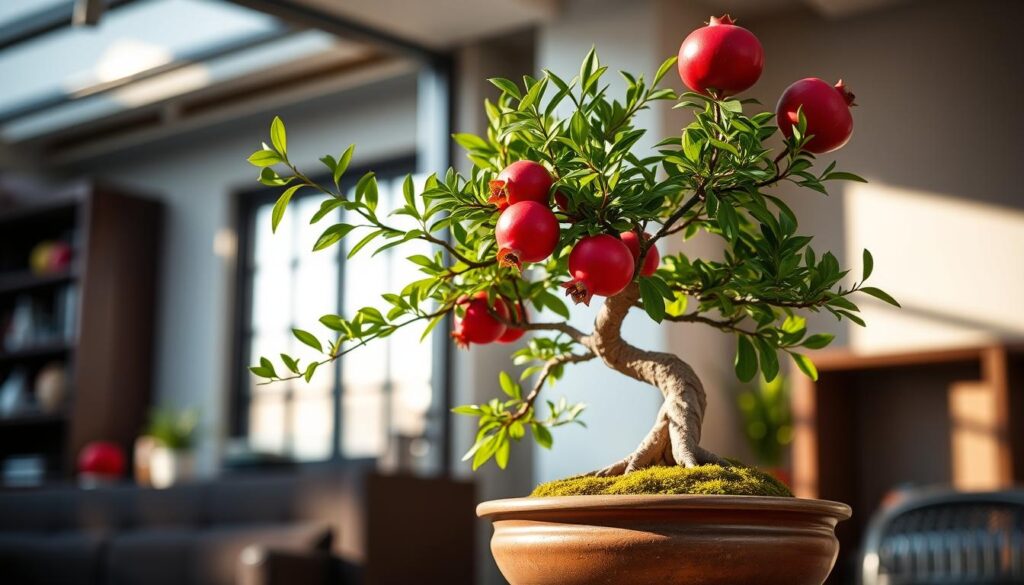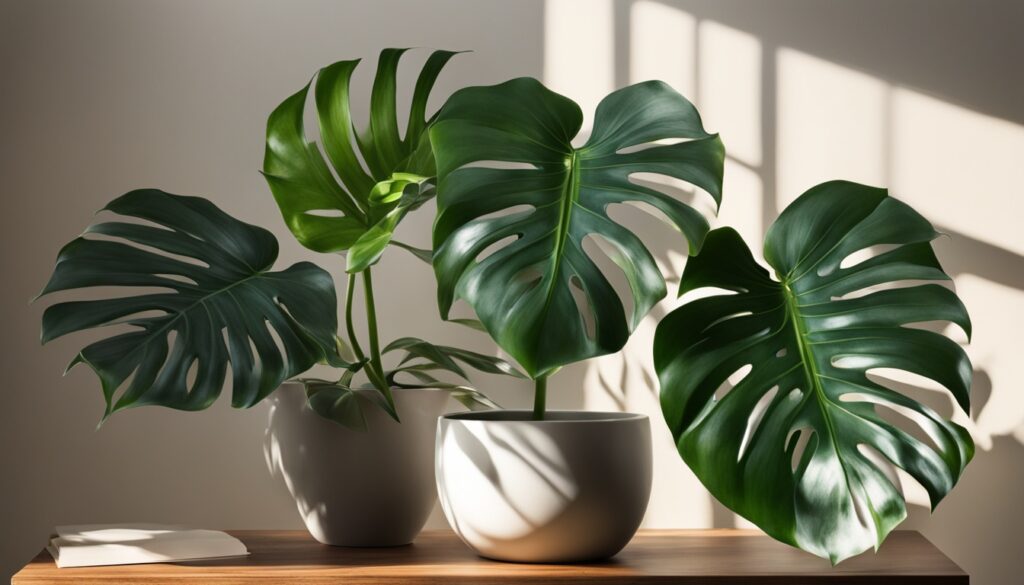Have you thought about growing a pomegranate tree bonsai at home? These small, fruit-bearing trees add beauty to any space. But why do people love growing pomegranate bonsai?
Pomegranate trees stand out because of their thick trunks and interesting bark. Their flowers and fruit are also eye-catching. Originating in the Middle East and Southeast Asia, pomegranate bonsai has been a favorite in Japan for centuries. It’s not the easiest to bonsai, but its unique look makes it a favorite.
Key Takeaways
- Pomegranate bonsai trees are suitable for both beginner and experienced growers
- Pomegranate bonsai require full sun exposure and moderate temperatures for optimal growth
- Proper repotting, pruning, and care are essential for the long-term health of pomegranate bonsai
- Pomegranate bonsai can be propagated from seeds, cuttings, or air-layering
- Outdoor pomegranate bonsai may need frost protection in temperate climates
Introduction to Pomegranate Tree Bonsai
The pomegranate bonsai tree has a long history, starting in the Middle East and Southeast Asia. It has become very popular in Japan, where bonsai art is loved. Its unique bark, colorful flowers, and ability to grow fruiting bonsai or edible bonsai make it a favorite among bonsai fans.
History and Origins
Pomegranate bonsai trees come from the Middle East and Asia’s rich gardening traditions. These small trees are known for their special looks and the challenge they offer to bonsai artists.
Why Choose Pomegranate for Bonsai
- Naturally twisted and gnarled appearance
- Vibrant, eye-catching flowers
- Ability to produce edible fruiting bonsai
- Unique and rewarding bonsai experience for enthusiasts
Characteristics of Pomegranate Bonsai
Pomegranate bonsai trees have many special features. Their twisted trunks, beautiful flowers, and the chance to grow edible bonsai fruit make them a unique choice. These trees offer a special and rewarding bonsai journey.
“The pomegranate bonsai tree is a true testament to the art of bonsai, blending natural beauty, historical significance, and the thrill of cultivating an indoor bonsai that can bear delicious fruit.”
Getting Started: Methods of Acquisition
Starting your pomegranate bonsai journey has a few paths. You can buy a pre-made bonsai tree or get a young tree from a nursery. This way, you can shape it yourself.
For those who enjoy growing things, starting from seed or cuttings is rewarding. It lets you tailor your tree’s growth. Seeds might not always match the parent tree, but cuttings do.
Professional Bonsai Purchase
Buying a pre-made bonsai is an investment. It gives you a mature tree right away. These trees have years of care, making them perfect for any space.
Nursery Selection
Getting a young tree from a nursery lets you shape it yourself. It takes time and effort but is very rewarding. You’ll see your low-maintenance houseplant grow into a beautiful bonsai.
Growing from Seeds or Cuttings
Starting from seeds or cuttings is exciting. Seeds might not always grow the same as the parent tree. But, cuttings ensure your new tree is a clone of the original.
| Method | Advantages | Challenges |
|---|---|---|
| Professional Bonsai Purchase |
|
|
| Nursery Selection |
|
|
| Growing from Seeds or Cuttings |
|
|
Choosing the right method is key to growing a successful pomegranate cultivation. Give your bonsai the right care and watch it thrive. With patience and dedication, you’ll have a beautiful pomegranate bonsai.
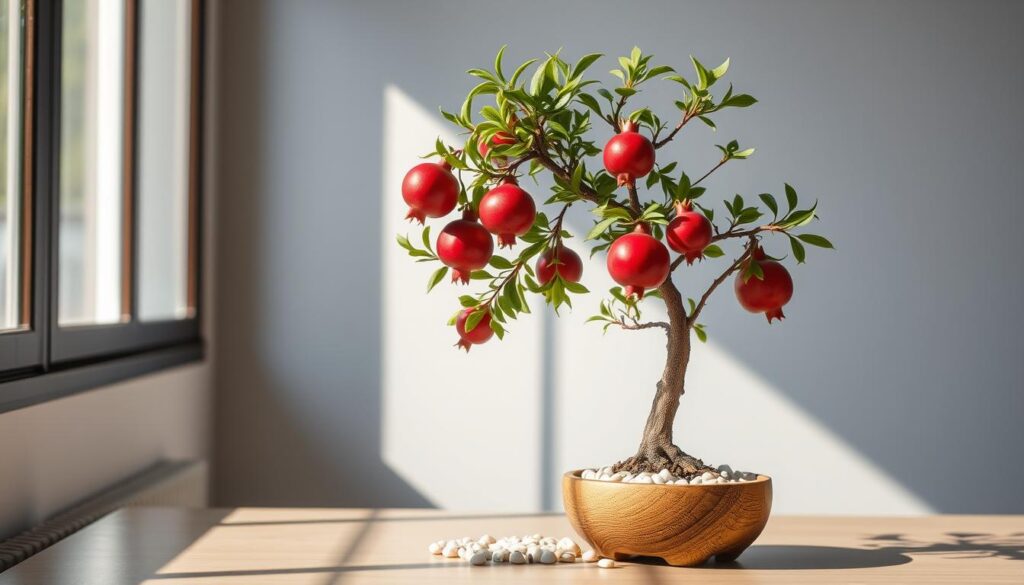
Ideal Growing Conditions
To grow a healthy decorative bonsai pomegranate tree, you need the right conditions. They love warm, sunny spots with good air flow. They do best in temperatures over 41°F (5°C) and need lots of sunlight, especially in summer. In winter, they can handle less light.
These plants don’t do well in cold, below 40°F (4.4°C). It’s key to keep them warm. They also like dry air and well-ventilated places. This is because they come from hot, dry areas like Armenia, northern India, and Iran.
The best soil for pomegranate tree bonsai is one that drains well and has a slightly acidic to neutral pH, not over 7. This helps them get the nutrients they need and keeps the roots healthy.
| Growing Condition | Ideal Range |
|---|---|
| Temperature | Above 41°F (5°C) |
| Sunlight | Abundant in summer, less in winter |
| Humidity | Low |
| Soil pH | Slightly acidic to neutral, not exceeding 7 |
“Pomegranate bonsai are heat-tolerant and thrive in warm, sunny conditions, but they struggle in cold temperatures and require well-draining, slightly acidic to neutral soil for optimal growth.”
Pomegranate Tree Bonsai Indoor and Outdoor Care
Caring for a pomegranate tree bonsai means adjusting its environment. It needs the right temperature and light. These dwarf pomegranates do well indoors and outdoors, but they need special care for each season.
Temperature Requirements
Pomegranate bonsai love warm temperatures over 41°F (5°C). They can handle some frost, but cold for too long is bad. If it gets too cold, move it indoors to keep it safe.
Seasonal Location Changes
For the best care, indoor bonsai stay in a bright, airy spot all year. But, they also need time outside in the warm months. In summer, put them in full sun. Then, move them to a bright indoor spot in winter to match their natural light cycle.
| Season | Recommended Location |
|---|---|
| Spring and Summer | Outdoors in full sun |
| Fall and Winter | Bright, well-ventilated indoor space |
By following these tips, your dwarf pomegranate bonsai will do great indoors and outdoors. It will have beautiful leaves and, with the right care, tasty fruit too.
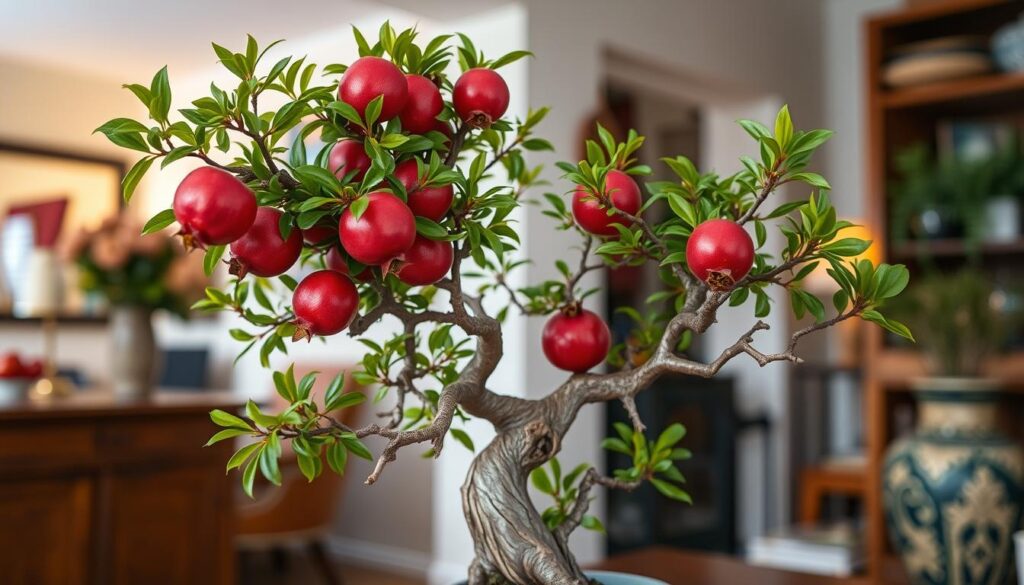
Essential Tools and Materials
To grow a beautiful miniature fruit tree like a pomegranate bonsai, you need the right tools and materials. Keeping your pomegranate cultivation healthy and long-lasting is key. Having the right equipment is essential.
Start with a good set of pruning shears for cutting and shaping. Wire is also crucial for shaping the branches. A watering can with a fine nozzle helps water your bonsai without harming the roots.
It’s important to use the right soil and container for your pomegranate bonsai. Choose bonsai soil that drains well and a container with holes for drainage. Use fertilizers made for bonsai trees to feed your tree.
For pests, keep organic insecticides ready to tackle any problems fast. A root rake and concave cutters are great for repotting and pruning roots. They help your bonsai grow strong and healthy.
With this toolkit, you’re ready to care for your pomegranate bonsai. Watch it grow and change over time.
“Bonsai is an art form that requires patience, attention to detail, and a deep appreciation for the natural world.”
| Essential Bonsai Tools | Purpose |
|---|---|
| Pruning Shears | Precise trimming and shaping |
| Bonsai Wire | Guiding branch formation |
| Watering Can with Fine Nozzle | Hydrating the bonsai without disturbing roots |
| Bonsai Soil | Providing the right growing medium |
| Bonsai Fertilizer | Supplying essential nutrients |
| Organic Pesticides | Controlling pests and diseases |
| Root Rake and Concave Cutters | Repotting and root pruning |
Soil and Potting Requirements
To grow a healthy edible bonsai or fruiting bonsai like the pomegranate, you need to focus on the soil and potting. Pomegranate bonsai do best in soil that drains well. This prevents water from pooling and causing root rot.
A mix made for bonsai or a homemade mix of akadama, pumice, and compost is great. It helps the tree get the nutrients it needs.
Keeping the soil pH right is key for your pomegranate bonsai’s health. Aim for a slightly acidic to neutral pH, no higher than 7. This helps the tree absorb nutrients well.
Drainage Considerations
Good drainage is essential for pomegranate bonsai. Use pots with lots of holes to let water out. This stops waterlogging and root suffocation. The pot should fit the tree, allowing for root growth while keeping the bonsai looking good.
Container Selection
- Choose shallow, wide pots for stability and root support.
- Go for pots made of unglazed ceramic or plastic for better air flow.
- Stay away from deep, narrow pots that can harm root growth and tree balance.
By picking the right soil, drainage, and container, you can give your pomegranate bonsai the best home. This ensures it stays healthy and vibrant for a long time.
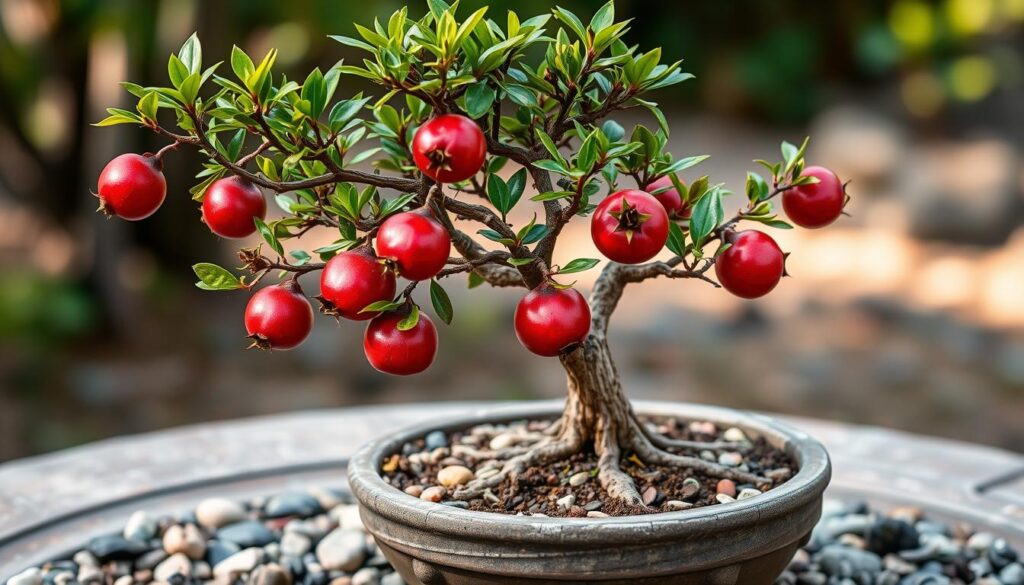
| Soil Composition | Drainage Considerations | Container Selection |
|---|---|---|
| Bonsai-specific mix or homemade blend of akadama, pumice, and organic potting compost | Containers with ample drainage holes; pot size proportionate to tree size | Shallow, wide containers made of unglazed ceramic or plastic |
“Bonsai requires enthusiasm and commitment, as the trees can live for hundreds of years and can be passed down through the generations.”
Watering and Humidity Management
Keeping the right moisture is key for your low-maintenance houseplant and indoor bonsai. Water your pomegranate bonsai when the soil feels dry. Water more often when it’s flowering or in the summer. In winter, keep the soil a bit moist but don’t overdo it.
Use good, non-calcareous water for your bonsai. Pomegranates like a dry environment. If your plant is in a humid spot, ensure good air flow to stop fungal problems. During hot times, water your bonsai twice a day to prevent dry soil.
“Proper watering for Bonsai involves allowing the soil to dry a bit between waterings to avoid overwatering.”
Indoor bonsai trees might need more moisture. You can mist them or use a pebble tray. Outdoor bonsai trees usually do well with natural humidity changes.
Finding the right balance between watering and humidity is crucial for your pomegranate bonsai’s health. Watch the soil moisture and adjust your care as needed. This way, your low-maintenance houseplant will flourish and bring joy for many years.
Pruning and Training Techniques
Maintaining a decorative bonsai pomegranate tree’s beauty needs careful pruning and training. Knowing when to prune and how to wire is key. This knowledge helps your bonsai thrive.
Seasonal Pruning Guidelines
Prune your pomegranate bonsai mainly in winter, from October to November or February to March. This is when it grows best. Cut new shoots to 4-6 inches to keep its shape.
To get lots of flowers, don’t cut off the tips where buds form. This helps your bonsai bloom beautifully.
Wiring Methods
Wiring is vital for shaping your pomegranate tree bonsai. Do it in winter when leaves are off and branches are soft. Young branches are easier to bend, while older ones need more care.
Take off the wire after six to twelve months. This prevents scarring and keeps your tree healthy.
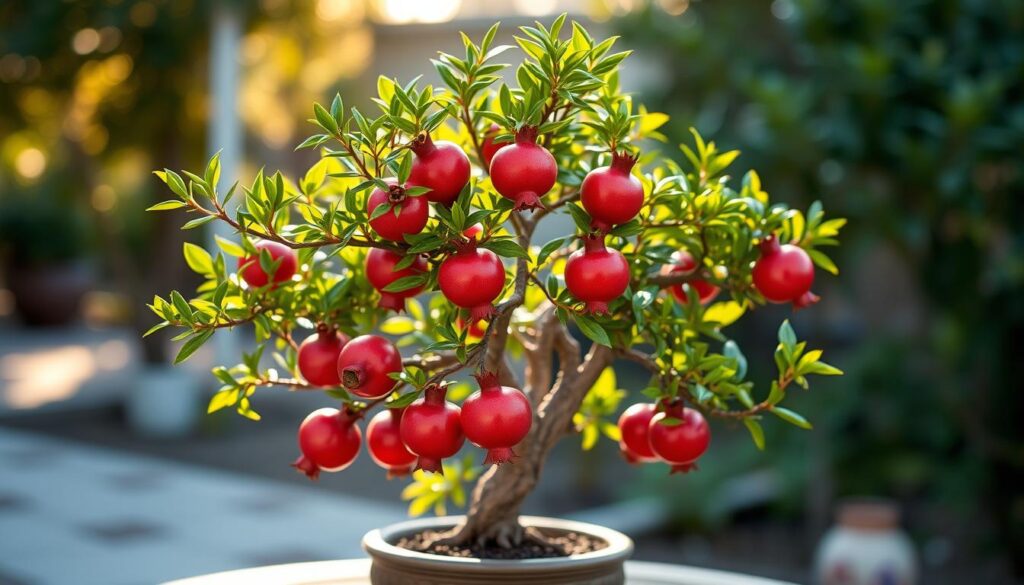
Learning to prune and wire is essential for your decorative bonsai pomegranate tree’s health and beauty. Follow these tips and you’ll create a stunning bonsai. It will be a miniature work of art that shows off this ancient craft.
Fertilization and Nutrition
Keeping your pomegranate bonsai well-fed is key for its growth and fruit production. To get lush leaves, lots of flowers, and juicy pomegranates, use a special fertilization plan. This plan is made just for this fruiting bonsai.
Start the growing season with a balanced organic fertilizer. Use a 5-10-5 or 15-30-15 NPK ratio every four weeks. This high-phosphorus mix helps with flowers and fruit. Don’t fertilize when the tree is blooming to keep the cycle natural.
Later, switch to a liquid organic fertilizer every week. This keeps nutrients flowing to your tree. Keep the soil pH between 5.5 and 7.0 for best health.
In the fall, cut back or stop fertilizing. This lets the tree rest for winter. After repotting, wait a few months before starting fertilization again. This avoids harming the roots and helps the tree adjust smoothly.
Watch for signs of too much fertilizer, like yellow leaves or a crust on the soil. If you see these, clean the soil and adjust your fertilizing schedule. With the right nutrients, your fruiting bonsai will flourish and give you plenty of fruit.
Regular pruning and trimming are also important. They keep your pomegranate bonsai healthy and strong. With a good care plan, you’ll have a stunning and fruitful pomegranate bonsai for many years.
“Pomegranates have been cultivated throughout the Middle East, India, and the Mediterranean region for several millennia, showcasing their enduring appeal and versatility.”
Common Pests and Diseases
Keeping your pomegranate tree bonsai healthy is key for its beauty and life span. These small trees can get sick or infested with pests. Knowing the common problems and how to prevent them helps your bonsai stay strong.
Prevention Methods
Good growing conditions help fight pests and diseases. Make sure your bonsai gets enough air, water, and sunlight. Also, check your bonsai often for signs of trouble and act fast.
Treatment Options
- For aphid infestations, use insecticidal soaps or horticultural oils to smother and suffocate the pests.
- Mealybugs can be controlled with neem oil or isopropyl alcohol-based sprays that disrupt their waxy coating.
- Mites can be effectively treated with miticides or by introducing predatory mites to your bonsai ecosystem.
- Borers can be manually removed by cutting out affected parts or treated with systemic insecticides.
- Slugs and snails can be deterred with barriers like copper tape or trapped using beer-baited traps.
- Fungal diseases like root rot and chlorosis can be managed with appropriate fungicides or by improving drainage and air circulation.
By watching your pomegranate tree bonsai closely and acting quickly, you can keep it healthy and vibrant. These steps help your bonsai thrive for years.
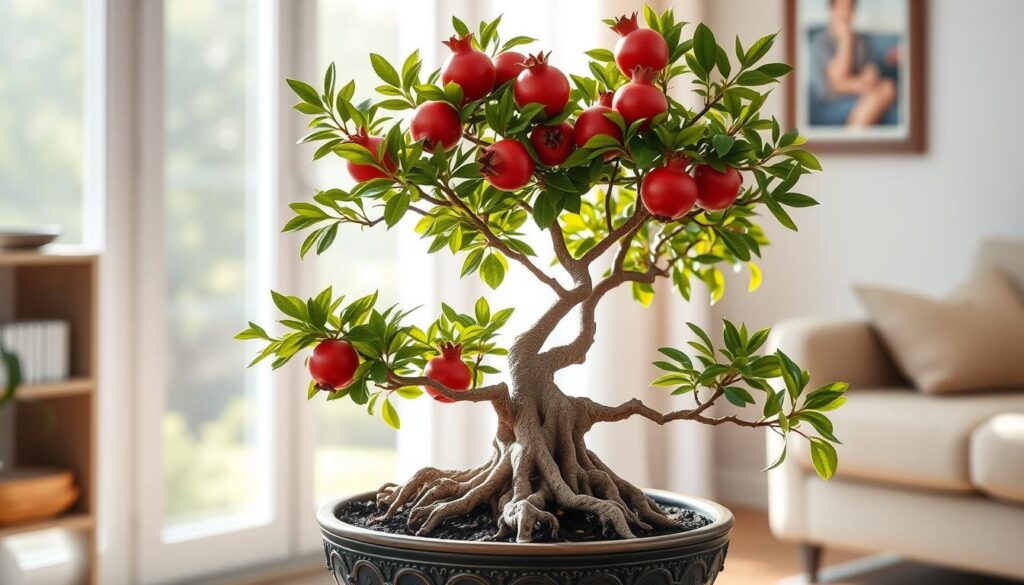
Seasonal Care Calendar
Growing a pomegranate tree bonsai needs careful seasonal care. Whether it’s a dwarf or full-sized bonsai, knowing your tree’s needs is key. This ensures it stays healthy and beautiful.
Spring: Revive and Replenish
When it gets warmer, start watering and fertilizing your bonsai again. Think about repotting if your tree needs more room. This helps it grow and get the nutrients it needs.
Summer: Sun, Water, and Pruning
Give your bonsai lots of sunlight in summer. Also, water it more to keep it hydrated. Keep up with fertilizing and prune new growth to keep its shape.
Fall: Preparing for Dormancy
Shorter days mean less watering and fertilizing for your bonsai. This helps it get ready for winter. Make sure it’s safe from frost.
Winter: Pruning and Protection
In winter, your bonsai needs less water and might need a big prune. Keep it safe from cold and frost. Move it if needed to protect it.
Watch your bonsai all year for pests or diseases. Adjust its care as needed. With this care calendar, your pomegranate bonsai will thrive and bring joy for years.
Propagation Methods and Success Tips
Growing a miniature fruit tree like the pomegranate tree bonsai at home is very rewarding. There are many ways to start growing your own pomegranate bonsai from scratch.
Seed propagation is a common method. Plant the seeds in moist soil in shallow containers. Cover them with clear plastic to keep the air moist until they germinate. Make sure the seeds get 8-12 hours of sunlight a day and keep the temperature between 68°F and 86°F.
You can also grow your bonsai from cuttings. Take 10-inch hardwood cuttings in late winter. Dip them in rooting hormone and plant them in moist, well-drained soil. This method can help your bonsai grow quickly.
Another way is air-layering, which works on mature bonsai branches. Make a small wound on the branch, wrap it in moist sphagnum moss, and put it in a plastic bag. This helps roots grow.
Remember, young pomegranate bonsai trees might need to be planted in the ground for a season. This helps them grow a strong trunk for bonsai styling. With patience and care, your miniature fruit tree can become a beautiful bonsai.
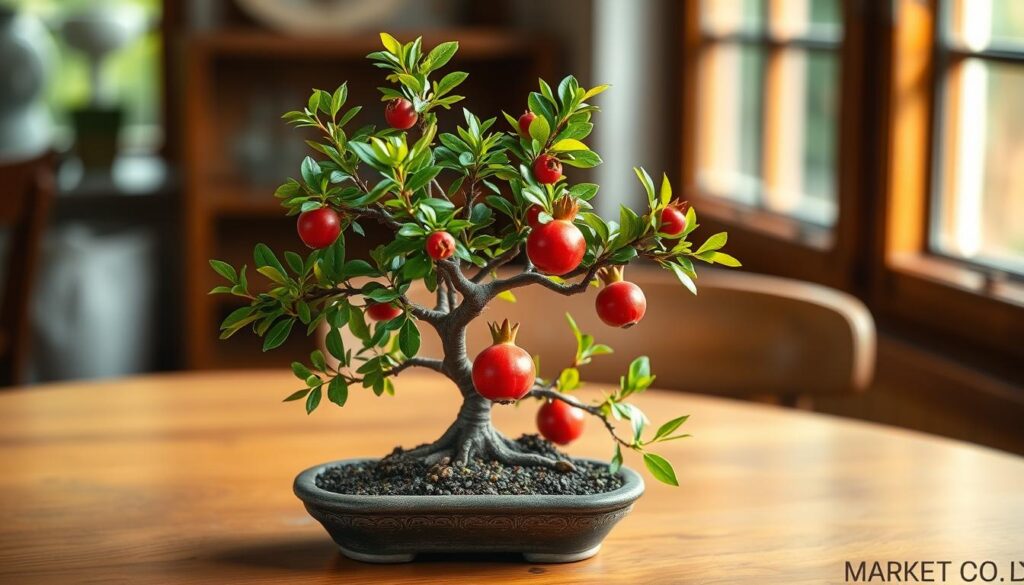
“The oldest known Bonsai tree is over 1,000 years old and is displayed at the Italian Bonsai Museum ‘Crespi.'”
Conclusion
Pomegranate tree bonsai are a unique and rewarding hobby. They are challenging but beautiful and fruitful. To succeed, you need to know about light, water, soil, and pruning.
With patience and dedication, you can grow stunning pomegranate bonsai. They are like living art, blending beauty with fruiting trees.
Pomegranate bonsai are not just pretty; they also give delicious fruit. Growing them is a rewarding process. It lets you shape and care for a living art piece that lasts for years.
They can be decorative bonsai or a source of fresh fruit. Pomegranate bonsai offer a special and rewarding gardening experience.
With the right care and techniques, growing pomegranate bonsai is fulfilling. This guide helps you start growing these beautiful and fruitful trees. They bring natural beauty and peace to your home.
